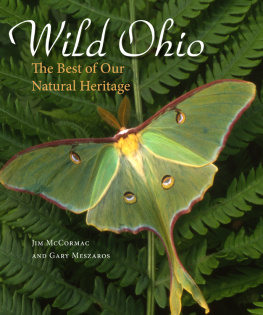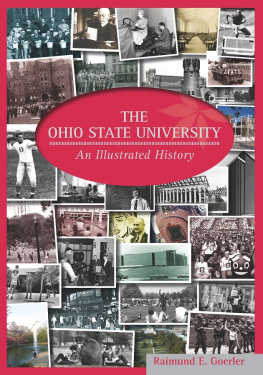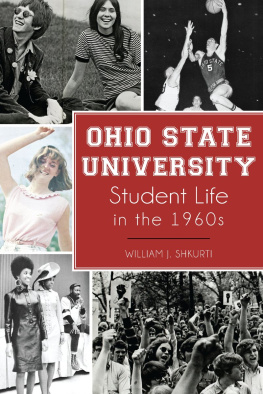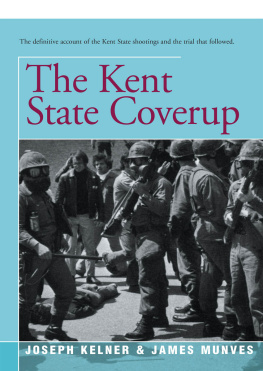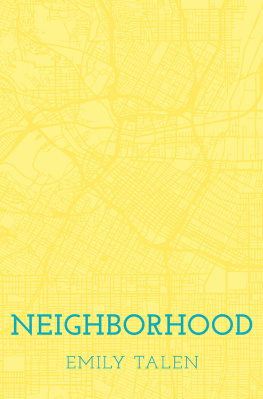
Published by The History Press
Charleston, SC 29403
www.historypress.net
Copyright 2014 by Emily Foster
All rights reserved
Front cover: images from the Ohio State University archive and the collection of Bob Singleton.
First published 2014
e-book edition 2014
ISBN 978.1.62585.032.4
Library of Congress Cataloging-in-Publication Data
Foster, Emily, 1945-
The Ohio State University District : a neighborhood history / Emily Foster.
pages cm
Includes bibliographical references and index.
print edition ISBN 978-1-62619-492-2 (paperback)
1. University District (Columbus, Ohio)--History. 2. Columbus (Ohio)--History. 3. Historic sites--Ohio--Columbus. 4. Columbus (Ohio)--Biography. 5. Columbus (Ohio)--Social conditions. I. Title.
F499.C76U554 2014
977.157--dc23
2014035071
Notice: The information in this book is true and complete to the best of our knowledge. It is offered without guarantee on the part of the author or The History Press. The author and The History Press disclaim all liability in connection with the use of this book.
All rights reserved. No part of this book may be reproduced or transmitted in any form whatsoever without prior written permission from the publisher except in the case of brief quotations embodied in critical articles and reviews.
CONTENTS
ACKNOWLEDGEMENTS
Without the dedication and hard work of the members of the University District Organizations archive committee, this book would not exist. These volunteers met for the first time in 2007. Their mission: to collect and archive memorabilia related to the history of the neighborhoods surrounding The Ohio State University and donate it as a first-of-a-kind special collection to the Ohio History Collection.
Over the past seven years, Fred Andrle, Ben Brace, Dianne Efsic, Pasquale Grado, Oliver Jones, Jon Marshall, Bill Rutherford, Bob Singleton, Doreen Uhas-Sauer and Chris Zacher have worked to collect and catalogue items, secure media attention to our efforts, design a website, create and host a community exhibition, collaborate on an oral history project, transcribe stories from oral history tapes and advise on the making of this book. Sadly, two committee members, Linda Ridihalgh and George Ziegler, passed away during our years of work, and we miss them greatly.
As chair of the archives committee and editor of this book, I am deeply grateful to all of them. Their enthusiasm and humor have made the committee both highly productive and tremendously fun.
Thanks of course go to the University District Organization (UDO), which created the committee and launched the ship of fools that sailed off to do the work of celebrating the districts history. The Ohio History Connection (OHC), which houses our memorabilia, has been an excellent steward of the collection. OHC representatives John Haas and Matt Benz offered wise counsel and literally put their shoulders to the work of loading up the boxes and large objects for storage at the OHC.
Much of the material in this volume comes from our committees collaboration with the Ohio State Center for Folklore Studies. It was a mutually beneficial relationship. Students in the oral history classes were provided subjects to interview who talked about history close to home, so to speak, and the students in turn supplied us with a rich source of tales and memories for this book. We thank in particular Ray Cashman, Dorothy Noyes, Galey Modan, Martha Sims and Cassie Patterson.
Michelle Drobik was especially helpful in searching the massive Ohio State Archive for images to help us illustrate the stories. While this book often spotlights the tensions that have existed between the neighborhood and the university, the folklore center and archive showcase the huge asset Ohio State can be for projects such as ours.
Unless otherwise noted, all stories in this volume were collected as part of an oral history collaboration between the UDO archive committee (History Shared, History Saved) and the Ohio State University Center for Folklore Studies. Stories from the oral history project were transcribed and freely edited for readability.
Finally, but not least, thanks to all those who contributed money, memorabilia and stories to the collection. Anyone who may be inspired to contribute in the future can contact Emily Foster at .
Introduction
THE UNIVERSITY DISTRICT
A CENTURY OF CHANGE AND CHALLENGE
This book grew out of two oral history projects. The first one, in the 1970s, focused on a handful of elderly neighbors who shared memories of life in the University District (UD) at the beginning of the twentieth century. It resulted in a much-viewed slide show called Lest We Forget (since expanded and preserved as Where Town Meets Gown on DVD). The second project was a collaboration between the University District Organizations archive committee (History Shared, History Saved) and the Ohio State University Center for Folklore Studies. Students in the universitys oral history classes interviewed more than one hundred people who lived and/or worked in the neighborhoods around The Ohio State University. The stories in this book come from both of those collections. Other neighbors added more stories, and a few are from the public record.
As a collection, they describe more than a century of life in Ohios most densely populated urban area, the University District adjoining Ohio State. With more than fifty-seven thousand students on its Columbus campus, Ohio State is often referred to as a city within a city. The sprawling University District that grew up on three sides of the university includes areas with differing demographics, histories and architectural styles. But they have one thing in common: each is affected by its proximity to the university.
South of campus, the UD extends to Fifth Avenue and includes the stately brick homes on Dennison Place (the Circles), the Peach District just north of that, the eclectic NECKO area in the western half and the working-class Weinland Park to the east of High Street. The contrast between the east, just now undergoing major redevelopment, and the already-gentrified western portion paints a clear picture of the socioeconomic diversity of the UD. Directly east of campus is the core student neighborhood, where many fraternity and sorority houses and multiparty rentals occupy what were once upper-middle-class residences. North of Lane Avenue, the Tuttle Park area west of High Street extending to the Olentangy River includes the Pavey developments on High and the neighborhood around West Patterson and West Oakland described by Ann Silverio in her memoir.
The University District is bounded by the Olentangy River, the Conrail tracks, Glen Echo Ravine and Fifth Avenue. From the UDO archive.
The UD has more designated historic neighborhoods than any other area of Columbus. Two of them, Indianola Forest and Iuka Ravine, both developed in the teens of the twentieth century, lie east of campus. The shady ravine with mature trees, brick streets and stone bridges has been a favorite walking and gawking place for generations. It still is lined with many large owner-occupied homes. The Northwood Park historic district north of campus features mainly Foursquare brick houses with big front porches and prides itself on its attractive street-corner flowerpots. Glen Echo, the farthest north neighborhood in the UD, is a cozy place of Arts and Crafts bungalows and frame houses, bordered by the Glen Echo Ravine that curves east down to High Street.




